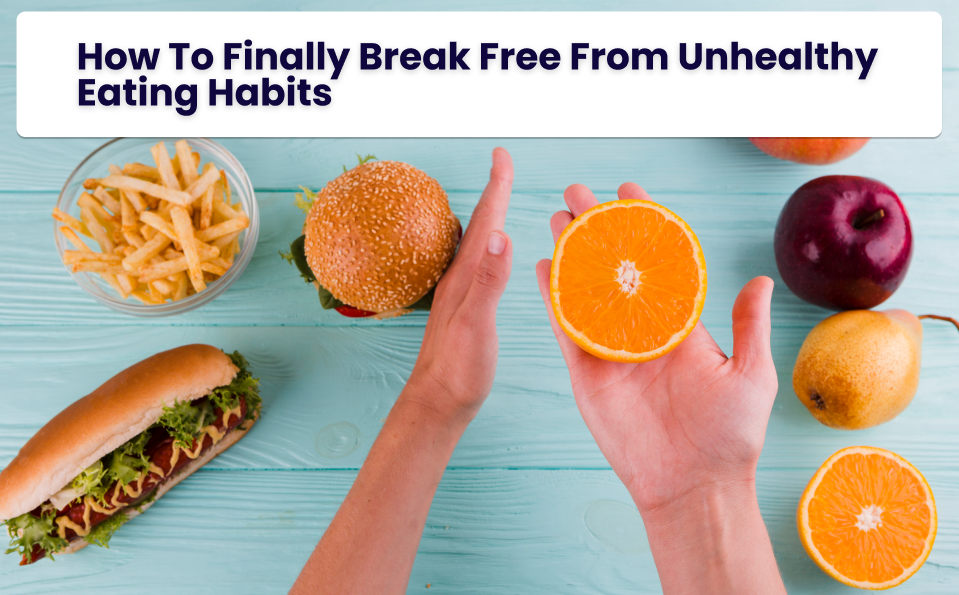
How to Break Unhealthy Eating Habits for Good
Introduction In today’s fast-paced world, unhealthy eating habits are a common struggle. Processed snacks, sugary treats, and fast food temptations can take a toll on health and well-being. Whether it’s late-night snacking or mindless eating, breaking these habits may seem daunting, but it’s not impossible. With a few practical tips and a mindset shift, you can regain control over your diet and improve your overall health. This guide focuses on sustainable strategies for breaking unhealthy eating habits for good, especially for those in the USA and Canada.
1. Understand Your Triggers

- Identify Emotional Eating Patterns: Stress, boredom, or loneliness often lead to unhealthy snacking. Recognizing these triggers is the first step.
- Cultural & Social Influences: In North America, celebrations and social gatherings often involve indulgent food. Being mindful of how these environments affect your choices is key.
- Take Notes: Keep a food journal to track what you eat and when, identifying patterns in your unhealthy eating habits.
2. Start with Small Changes

- Don’t Go Cold Turkey: Eliminating all junk food at once may backfire. Start by reducing portion sizes or limiting certain foods to specific days.
- Replace, Don’t Eliminate: Instead of cutting out all sweets, swap processed snacks for healthier alternatives like fruits, nuts, or smoothies. Slowly replace one unhealthy habit at a time.
3. Meal Planning and Preparation

- Plan Ahead: Prepare meals in advance to avoid reaching for convenience foods. When meals are planned, you’re less likely to grab fast food.
- Batch Cooking: For busy North Americans, batch cooking can be a game-changer. Set aside time on weekends to cook meals that will last throughout the week.
- Smart Snacking: Keep healthy snacks, such as nuts, yogurt, or veggie sticks, within reach so you don’t opt for chips or candy.
4. Adopt Mindful Eating Practices

- Eat Without Distractions: Focus on your food instead of eating while watching TV or scrolling through your phone. This helps you recognize when you’re full.
- Portion Control: Use smaller plates to avoid overeating, and be conscious of portion sizes, especially in restaurants, where servings are often oversized.
- Savor Every Bite: Take your time and enjoy the flavors. Eating slowly gives your brain time to signal when you’re full.
5. Stay Hydrated

- Thirst vs. Hunger: Often, we mistake thirst for hunger. Keep a water bottle with you throughout the day and make sure you’re hydrated before grabbing a snack.
- Infused Water: For those who find water plain, try adding lemon, cucumber, or berries to keep it flavorful and satisfying.
6. Practice Self-Compassion

- Avoid All-or-Nothing Thinking: It’s normal to indulge occasionally. If you slip up, don’t be too hard on yourself. The key is to get back on track instead of giving up completely.
- Focus on Progress, Not Perfection: Celebrate small wins, whether it’s swapping out soda for water or choosing a healthier snack.
7. Surround Yourself with Support

- Create a Healthy Environment: Keep your kitchen stocked with nutritious foods and limit the availability of junk food at home.
- Involve Friends and Family: Let others know about your goals and ask for support in making better food choices. Meal planning and healthy eating can be a shared activity.
8. Set Realistic, Achievable Goals

- SMART Goals: Set Specific, Measurable, Achievable, Relevant, and Time-bound goals. For example, aim to cut down on processed sugar by 50% within the next month.
- Track Progress: Use apps or a simple journal to track your improvements over time. Celebrate milestones to stay motivated.
9. Seek Professional Help if Needed

- Dietitians and Nutritionists: If breaking unhealthy habits feels overwhelming, consider consulting a dietitian. They can help tailor a plan that works for you.
- Therapy for Emotional Eating: For those dealing with emotional eating, cognitive-behavioral therapy (CBT) can be effective in helping address underlying triggers.
Summary
Breaking unhealthy eating habits takes time, patience, and a commitment to better health. By understanding your triggers, making gradual changes, and practicing mindful eating, you can develop healthier habits that stick for life. Whether you’re in the USA or Canada, the road to better nutrition is a rewarding journey that leads to improved energy, mood, and overall well-being.
FAQ
How long does it take to break unhealthy eating habits?
It varies from person to person, but it typically takes a few weeks to a few months to establish new habits. The key is consistency and patience.
What should I do if I slip up and eat junk food?
Don’t be too hard on yourself. Acknowledge the slip-up, learn from it, and get back on track. Focus on your long-term goals.
Can I still eat my favorite foods while breaking unhealthy eating habits?
Yes, moderation is key. It’s about making healthier choices most of the time, but occasional indulgence is perfectly fine.
How can I reduce cravings for unhealthy foods?
Try incorporating more whole foods into your meals, staying hydrated, and getting enough sleep. Emotional eating triggers can also be addressed with mindfulness or therapy





